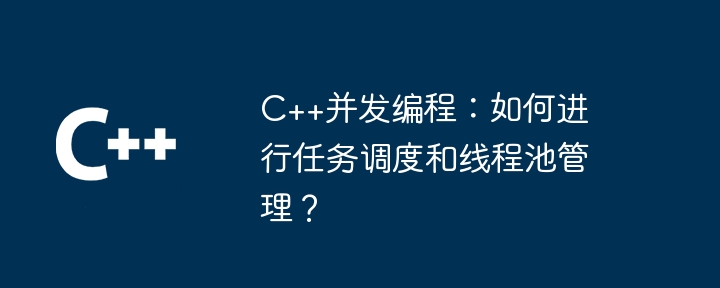C++並發程式設計:如何進行任務排程和執行緒池管理?
任務排程和執行緒池管理是 C 並發程式設計中提高效率和可擴展性的關鍵。任務調度:使用 std::thread 建立新執行緒。使用 join() 方法加入執行緒。執行緒池管理:建立 ThreadPool 對象,指定執行緒數量。使用 add_task() 方法新增任務。呼叫 join() 或 stop() 方法關閉執行緒池。

C 並發程式設計:任務排程與執行緒池管理
##簡介
在同時編程中,任務調度和執行緒池管理對於提高應用程式的效率和可擴展性至關重要。本文將引導您了解 C 中任務調度的概念,並展示如何使用 C 11 標準中的std::thread 和 std::mutex 來管理執行緒池。
任務排程
任務排程涉及指派和執行非同步任務。在C 中,可以使用std::thread 來建立新線程:
std::thread t([]() {
// 执行异步任务
});join() 方法:
t.join();
執行緒池管理
執行緒池是一個預先建立並管理的執行緒集合,可用來處理任務。使用執行緒池可以避免重複建立和銷毀執行緒的開銷。 以下是如何在C 中建立和管理執行緒池:class ThreadPool {
public:
ThreadPool(int num_threads) {
for (int i = 0; i < num_threads; i++) {
threads_.emplace_back(std::thread([this]() { this->thread_loop(); }));
}
}
void thread_loop() {
while (true) {
std::function<void()> task;
{
std::lock_guard<std::mutex> lock(mtx_);
if (tasks_.empty()) {
continue;
}
task = tasks_.front();
tasks_.pop();
}
task();
}
}
void add_task(std::function<void()> task) {
std::lock_guard<std::mutex> lock(mtx_);
tasks_.push(task);
}
void stop() {
std::unique_lock<std::mutex> lock(mtx_);
stop_ = true;
}
~ThreadPool() {
stop();
for (auto& t : threads_) {
t.join();
}
}
private:
std::vector<std::thread> threads_;
std::queue<std::function<void()>> tasks_;
std::mutex mtx_;
bool stop_ = false;
};- 建立一個執行緒池對象,指定要建立的線程數。 使用
- add_task()
方法將任務加入到執行緒池。呼叫 - join()
或stop()方法來關閉執行緒池並等待所有任務完成。
實戰案例
以下是使用執行緒池在多核心系統上執行並發任務的範例:#include <iostream>
#include <vector>
#include "thread_pool.h"
int main() {
ThreadPool pool(4);
std::vector<std::future<int>> futures;
for (int i = 0; i < 10000; i++) {
futures.push_back(pool.add_task([i]() { return i * i; }));
}
for (auto& f : futures) {
std::cout << f.get() << std::endl;
}
return 0;
}結論
透過使用std::thread 和執行緒池,可以有效地管理C 中的並發任務。無論是多核心系統上的科學運算還是需要處理大量請求的 Web 服務,執行緒調度和執行緒池管理都是提高程式碼效率和可擴展性的關鍵。
以上是C++並發程式設計:如何進行任務排程和執行緒池管理?的詳細內容。更多資訊請關注PHP中文網其他相關文章!

熱AI工具

Undresser.AI Undress
人工智慧驅動的應用程序,用於創建逼真的裸體照片

AI Clothes Remover
用於從照片中去除衣服的線上人工智慧工具。

Undress AI Tool
免費脫衣圖片

Clothoff.io
AI脫衣器

Video Face Swap
使用我們完全免費的人工智慧換臉工具,輕鬆在任何影片中換臉!

熱門文章

熱工具

記事本++7.3.1
好用且免費的程式碼編輯器

SublimeText3漢化版
中文版,非常好用

禪工作室 13.0.1
強大的PHP整合開發環境

Dreamweaver CS6
視覺化網頁開發工具

SublimeText3 Mac版
神級程式碼編輯軟體(SublimeText3)
 C#與C:歷史,進化和未來前景
Apr 19, 2025 am 12:07 AM
C#與C:歷史,進化和未來前景
Apr 19, 2025 am 12:07 AM
C#和C 的歷史與演變各有特色,未來前景也不同。 1.C 由BjarneStroustrup在1983年發明,旨在將面向對象編程引入C語言,其演變歷程包括多次標準化,如C 11引入auto關鍵字和lambda表達式,C 20引入概念和協程,未來將專注於性能和系統級編程。 2.C#由微軟在2000年發布,結合C 和Java的優點,其演變注重簡潔性和生產力,如C#2.0引入泛型,C#5.0引入異步編程,未來將專注於開發者的生產力和雲計算。
 vscode在哪寫代碼
Apr 15, 2025 pm 09:54 PM
vscode在哪寫代碼
Apr 15, 2025 pm 09:54 PM
在 Visual Studio Code(VSCode)中編寫代碼簡單易行,只需安裝 VSCode、創建項目、選擇語言、創建文件、編寫代碼、保存並運行即可。 VSCode 的優點包括跨平台、免費開源、強大功能、擴展豐富,以及輕量快速。
 Golang和C:並發與原始速度
Apr 21, 2025 am 12:16 AM
Golang和C:並發與原始速度
Apr 21, 2025 am 12:16 AM
Golang在並發性上優於C ,而C 在原始速度上優於Golang。 1)Golang通過goroutine和channel實現高效並發,適合處理大量並發任務。 2)C 通過編譯器優化和標準庫,提供接近硬件的高性能,適合需要極致優化的應用。
 Golang vs.C:性能和速度比較
Apr 21, 2025 am 12:13 AM
Golang vs.C:性能和速度比較
Apr 21, 2025 am 12:13 AM
Golang適合快速開發和並發場景,C 適用於需要極致性能和低級控制的場景。 1)Golang通過垃圾回收和並發機制提升性能,適合高並發Web服務開發。 2)C 通過手動內存管理和編譯器優化達到極致性能,適用於嵌入式系統開發。
 Python與C:學習曲線和易用性
Apr 19, 2025 am 12:20 AM
Python與C:學習曲線和易用性
Apr 19, 2025 am 12:20 AM
Python更易學且易用,C 則更強大但複雜。 1.Python語法簡潔,適合初學者,動態類型和自動內存管理使其易用,但可能導致運行時錯誤。 2.C 提供低級控制和高級特性,適合高性能應用,但學習門檻高,需手動管理內存和類型安全。
 Golang和C:性能的權衡
Apr 17, 2025 am 12:18 AM
Golang和C:性能的權衡
Apr 17, 2025 am 12:18 AM
Golang和C 在性能上的差異主要體現在內存管理、編譯優化和運行時效率等方面。 1)Golang的垃圾回收機制方便但可能影響性能,2)C 的手動內存管理和編譯器優化在遞歸計算中表現更為高效。
 表演競賽:Golang vs.C
Apr 16, 2025 am 12:07 AM
表演競賽:Golang vs.C
Apr 16, 2025 am 12:07 AM
Golang和C 在性能競賽中的表現各有優勢:1)Golang適合高並發和快速開發,2)C 提供更高性能和細粒度控制。選擇應基於項目需求和團隊技術棧。
 vscode如何執行代碼
Apr 15, 2025 pm 09:51 PM
vscode如何執行代碼
Apr 15, 2025 pm 09:51 PM
在 VS Code 中執行代碼只需六個步驟:1. 打開項目;2. 創建和編寫代碼文件;3. 打開終端;4. 導航到項目目錄;5. 使用適當的命令執行代碼;6. 查看輸出。






